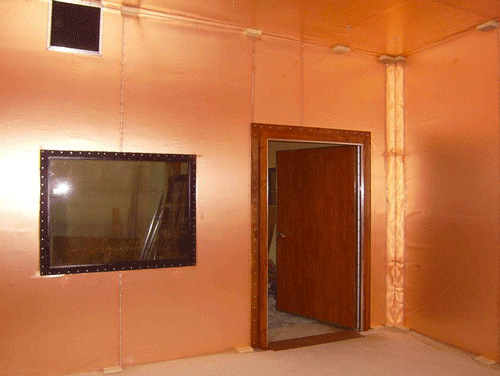
RF spectrum in the range of MRI
Click to enlarge
Click to enlarge
Radiofrequency (RF) shielding of an MR scanner is mandatory and serves two functions: 1) to prevent extraneous electromagnetic radiation from contaminating/distorting the MR signal, and 2) to prevent electromagnetic radiation generated by the MR scanner from causing interference in nearby medical devices.
As shown in the accompanying table, the frequencies of different strength MRI scanners overlap with those used by various private and commercial communication devices. (As a point of reference, FM radio occupies the band from 88-108 MHz). If your scanner happens to be sited next to a broadcast TV station or home with a ham radio enthusiast, you may be in trouble. But this is rare. The most common form of RF interference comes from noise generated from nearby electrical equipment (transformers, motors, pumps) or electronic devices (computers, pulse oximeters, cardiac monitors). As a rule, most manufacturers require that the magnet room to have at least 100dB of RF attenuation at the Larmor frequency.
As shown in the accompanying table, the frequencies of different strength MRI scanners overlap with those used by various private and commercial communication devices. (As a point of reference, FM radio occupies the band from 88-108 MHz). If your scanner happens to be sited next to a broadcast TV station or home with a ham radio enthusiast, you may be in trouble. But this is rare. The most common form of RF interference comes from noise generated from nearby electrical equipment (transformers, motors, pumps) or electronic devices (computers, pulse oximeters, cardiac monitors). As a rule, most manufacturers require that the magnet room to have at least 100dB of RF attenuation at the Larmor frequency.
|
Specialized construction firms (such as ETS-Lindgren or National MRI Shielding) are generally enlisted in the design and building oversight for the RF-shielded magnet room. The ideal room consists of three nested components: 1) an outer shell for structural support; 2) a middle metallic RF-shield; and 3) an interior layer made of finish materials.
The RF-shield must encircle the entire room - walls, floor, and ceiling. Such a conductive box used to shield out stray electromagnetic interference is also known as a Faraday cage. Virtually any type of metal can be used, including aluminum and galvanized steel. However, the most common RF-enclosure consists of wood panels wrapped with copper. At the range of frequencies used for MRI the skin conductive depth for copper is very small (on the order of 0.1 mm), meaning that only a thin layer of metallic shielding is required. |

Copper RF-shielding in a magnet room. Image courtesy of Cliff Hess, National MRI Shielding
|
The floor is generally made of monolithic copper covered over with a solid antistatic flooring material. The interior walls are typically finished with drywall. The ceiling is suspended from the RF shield to allow space for recessed lighting and mechanicals. The door must not allow any RF leakage, being sealed by a set of electrical contact strips or a continuous metallic pneumatic tube. Because of repetitive opening and closing, RF-seals around the door are frequently damaged and a common source of RF-leakage into the room. Windows are laminated with blackened copper mesh between two pieces of glass that connects peripherally with the RF enclosure walls.
Advanced Discussion (show/hide)»
No supplementary material yet. Check back soon!
References
ETS-Lindgren. MRI shielding architectural site planning guide (pdf). September, 2009:1-34.
Weibler J. Properties of metals used for RF shielding (pdf). EMC Test & Design, December, 1993.
ETS-Lindgren. MRI shielding architectural site planning guide (pdf). September, 2009:1-34.
Weibler J. Properties of metals used for RF shielding (pdf). EMC Test & Design, December, 1993.
Related Questions
If the scanner room is shielded against radiofrequencies, how do you get tubes, pipes and wires through the walls?
If the scanner room is shielded against radiofrequencies, how do you get tubes, pipes and wires through the walls?

